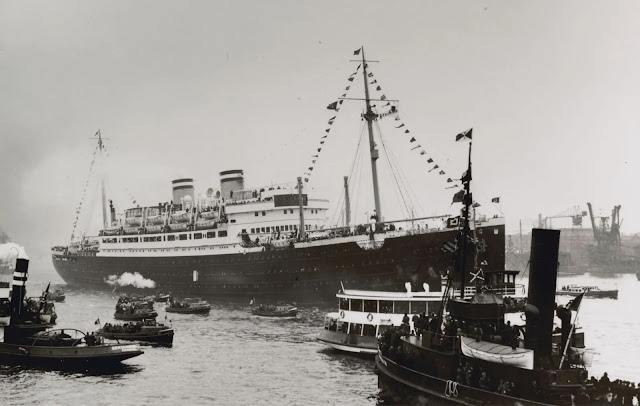3: The Voyage of the Damned
After Kristallnacht in November 1938, many Jews within Germany decided that it was time to leave. Though many German Jews had emigrated in the preceding years, the Jews who remained had a more difficult time leaving the country because emigration policies had been toughened. By 1939, not only were visas needed to be able to enter another country but money was also needed to leave Germany. Since many countries, especially the United States, had immigration quotas, visas were near impossible to acquire within the short time spans in which they were needed. For many, the visas were acquired after it was too late.
On May 13, 1939, the German transatlantic liner St. Louis sailed from Hamburg, Germany, for Havana, Cuba. On the voyage were 937 passengers. Almost all were Jews fleeing from the Third Reich. Most were German citizens, some were from eastern Europe, and a few were officially "stateless."
The majority of the Jewish passengers had applied for US visas, and had planned to stay in Cuba only until they could enter the United States. But by the time the St. Louis sailed, there were signs that political conditions in Cuba might keep the passengers from landing there. The US State Department in Washington, the US consulate in Havana, some Jewish organizations, and refugee agencies were all aware of the situation.
When the ship arrived in Havana, the Cuban government, headed by President Federico Laredo Brú, refused to accept the foreign refugees. Although passengers had previously purchased legal visas, they could not enter Cuba either as tourists (laws related to tourist visas had recently been changed) or as refugees seeking political asylum. On May 5, 1939, four months before World War II began, Havana abandoned its former pragmatic immigration policy and instead issued Decree 937, which "restricted entry of all foreigners except U.S. citizens requiring a bond of $500 and authorization by the Cuban secretaries of state and labor. Permits and visas issued before May 5 were invalidated retroactively. None of the passengers were aware that the Cuban government had retroactively invalidated their landing permits.
After the ship had been in the harbor for five days, only 28 passengers were allowed to disembark in Cuba. Twenty-two were Jews who had valid United States visas; four were Spanish citizens and two were Cuban nationals, all with valid entry documents. The last admitted was a medical evacuee, a desperate passenger who attempted a suicide, and was allowed hospitalization in Havana.
Prohibited from landing in Cuba, Captain Gustav Schröder took the ship and its passengers to Florida. Some histories recount that on June 4, 1939, Schröder believed he was being prevented from trying to land St. Louis on the Florida shore. America not only refused their entry but even fired a warning shot to keep them away from Florida's shores". Legally the refugees could not enter the US on tourist visas, as they had no return addresses. The US had passed the Immigration Act of 1924 that restricted numbers of new immigrants from eastern and southern Europe.
Records show American officials Secretary of State Cordell Hull and Secretary of the Treasury Henry Morgenthau had made efforts to persuade Cuba to accept the refugees, quite like the failed attempts by the American Jewish "Joint" Distribution Committee, which pleaded with the government.
Schröder said he circled off the coast of Florida after leaving Cuba, hoping for permission to enter the United States. Neither Hull nor U.S. President Franklin Delano Roosevelt chose to intervene to admit the refugees. At one point, he considered running aground along the coast to allow the refugees to escape. He was shadowed by US Coast Guard vessels that prevented such a move. US Coast Guard historians maintain the two cutters involved were not ordered to turn away St. Louis, but dispatched "out of concern for those on board". Ultimately the United States did not provide for entry of the refugees.
The British Prime Minister Neville Chamberlain agreed to take 288 (32 percent) of the passengers, who disembarked and travelled to the UK via other steamers. After much negotiation by Schröder, the remaining 619 passengers were also allowed to disembark at Antwerp. 224 (25 percent) were accepted by France, 214 (23.59 percent) by Belgium, and 181 (20 percent) by the Netherlands. The ship returned to Hamburg without any passengers. The following year, after the Battle of France, and the Nazi occupations of Belgium, France, and the Netherlands in May 1940, all the Jews in those countries were subject to high risk, including the recent refugees.
Based on the survival rates for Jews in various countries during the war and deportations, historians have estimated that 180 of St. Louis refugees in France, 152 of those in Belgium and 60 of those in the Netherlands survived the Holocaust. Including the passengers who landed in England, of the original 936 refugees (one man died during the voyage), roughly 709 survived the war and 227 died. Later research tracing each passenger has determined that 254 (29.2 percent) of those who returned to continental Europe were murdered during the Holocaust.
A puzzling piece to this picture is, where was President Roosevelt? Why wasn't he involved in public explanations for these serious decisions that were being made? By effectively denying the passenger's access to the United States, Roosevelt ultimately passed a death sentence onto these passengers. With nowhere to go and a home country that was waiting in Hamburg to send them to concentration camps, Roosevelt's lack of response clearly indicated that did not want to get involved in this act of humanity. He could have issued an executive order to admit additional refugees, which would have saved the lives of these passengers. Instead he chose to keep silent about the whole situation.




Comments
Post a Comment